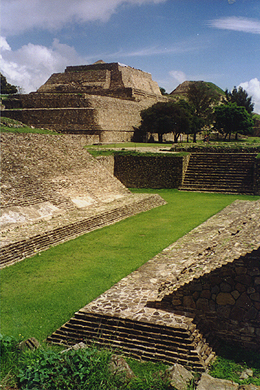The First Known Use of Rubber
I'm sure there's not a basketball fan out there who hasn't had this experience: You're sitting there watching the game on TV, and you think to yourself, "This game would be a lot more fun if after every game they killed the losing team."
Well, that would make the sport (and you) a lot more blood-thirsty, but believe it or not, this was actually how an early form of basketball was played at one time.
Long, long ago, before Europeans came to America, the Maya and other people of Central America played a game not too different from basketball. In this game, players tried to throw a ball through stone rings at the ends of a courtyard. There were many variations on the game. In one version, the winning team won the clothes of the losing team. Just why anybody would want the sweaty clothes of a basketball team at the end of a game is beyond me.

Ancient Mesoamerican ball
court in Monte Albán, Mexico.
In a more famous version, when one Mayan kingdom fought another one, prisoners of war were forced to play the home team, and the losing team was sacrificed to the gods of good sportsmanship or some other such deity. Guess which team had practiced a whole lot before the match-up. I suppose this incentive to win added to the excitement of the sport as every game was necessarily between two undefeated teams. In other variations of the game, both teams were sacrificed, which might make it hard to recruit teams to play.
The interesting thing about these games, aside from the post-game ceremonies, was the ball itself. Over five hundred years ago, these ancient basketball players were using rubber balls, made from polyisoprene. They got this polyisoprene from the sap of a tree, a tree called hevea brasiliensis. The Mayans were no fools (unless you count team rewards as foolishness), and they came up with a lot of uses for this stuff. The writings of early Spanish explorers tell us that Mayans would stick their feet in a tub of hot polyisoprene to make custom fitted waterproof boots. No doubt the Mayans themselves wrote about their cool boots, too, but the conquistadores burned all the Mayan's own writings so we'll never know now.
It goes without saying that the Spanish explorers thought this tree sap that kept your feet dry was some pretty impressive stuff. But it never took off back home in Europe. Polyisoprene has some inherent flaws. When it gets hot, it gets runny and gooey, which means your feet with rubber boots would stick to the sidewalk. What's worse is it gets hard and brittle when it gets cold, so your boots would crack with each step in the winter time. In Europe, where it gets cold a lot more than it gets hot, this was a particularly nasty problem.
The only thing that the Europeans could really do with polyisoprene was to rub it over pencil marks to erase them. It wasn't long before this would-be wonder material became known as "rubber".
So rubber languished for about three hundred years humbly ridding the world of writing mistakes. Then in the 1800s, people not only figured out how to use polyisoprene for more things because they found out how to make it better. The first new use for the magic tree sap was to sandwich a layer of rubber latex between two layers of cotton fabric, and use this sandwich to make waterproof raincoats. This was the famous "mackintosh" raincoat, named for the Scottish chemist, Charles Macintosh, who invented it. If you ever read Beatrix Potter's The Tale of Mr. Jeremy Fisher when you were a kid, you will remember that our hero, a frog named Mr. Jeremy Fisher, narrowly escaped being eaten by a fish because the fish hated the taste of the mackintosh raincoat he was wearing, and spat our hero back out onto a lilly pad. The mackintosh was also one of the first polymeric composite materials.
Unfortunately, these raincoats still got sticky in hot weather and stiff when it was cold. This problem was being tackled by a unsuccessful tinkerer in America named Charles Goodyear. He must have been something of a klutz, because he accidentally dumped sulfur into a pot of polyisoprene that was cooking on his stove. Wouldn't you know it, the rubber he got from this accident was just what the world was looking for! It stayed flexible in the cold, and didn't get runny when it was hot. He called his process vulcanization. What he'd really done was to figure out how to crosslink the rubber. The real science he did wasn't to have the accident, but to observe how it happened, what the results were, and then figure out why. So that's why he's something of a hero in science circles.
 Return to the Elastomer Page
Return to the Elastomer Page
 Return to
Macrogalleria Directory
Return to
Macrogalleria Directory